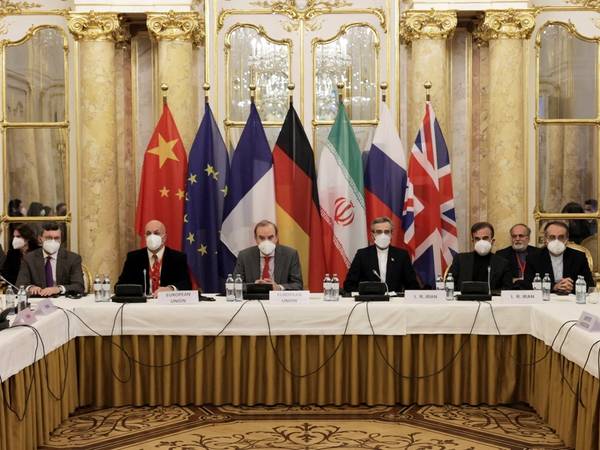A US-Iranian deal taking shape in Vienna lays out phases of mutual steps to bring both sides back into full compliance with the 2015 nuclear agreement, Reuters reported.
The draft text of the agreement, which is more than 20 pages long, stipulates a sequence of steps to be implemented once it has been approved by the remaining parties to the deal, starting with a phase including Iran suspending enrichment above 5% purity, three diplomats familiar with negotiations said.
In the draft being shaped oil sanctions are not included in the first phase, which begins with prisoners and cash release as well as a reduction in the level of Iranian uranium enrichment, according to Reuters.
Reuters news agency noted diplomats “citing the now hackneyed principle that nothing is agreed until everything is agreed.”
The Russian envoy to the talks, Mikhail Ulyanov told Iran International after the release of the Reuters report that parties would reach agreement "definitely by the end of February." He also dismissed the Reuters reference to a release of prisoners, saying that it was not a part of the JCPOA.
The talks have grappled with reconciling which sanctions the United States would need to remove to return to the deal, the JCPOA (Joint Comprehensive Plan of Action), and exactly how the Iranian nuclear program, expanded and improved since 2019, would be brought back within JCPOA limits.
But there have also been complex negotiations over ‘sequencing,’ agreeing a timetable as to how and when both the US and Iran would return to the JCPOA, with proposed steps reportedly included in a 20-page draft document on restoring the deal.
Such sequencing, Thursday’s Reuters report suggested, would begin with a phase in which Iran would scale back enrichment to 5 percent from current levels reaching 60 percent, before subsequently returning to the 3.67 percent cap set by the JCPOA.
The text also refers to step-by-step sequencing measures to be taken by the US, including withdrawing threatened punitive action against Korean banks should they release $7 billion owed to Iran for oil exports, sales that were specifically targeted under the ‘maximum pressure’ sanctions introduced by the US after 2018, when President Donald Trump withdrew from the JCPOA.
The steps outlined in the sequencing would lead, Reuters suggested, to what is already being called ‘Reimplementation Day,’ a date by which the JCPOA would be back in place, around one to three months after basic agreement.
But agreement on sequencing depends on agreement on the final goal, and what would be required from both sides to return to the agreement. Hence “now hackneyed principle that nothing is agreed until everything is agreed.”
Flexibility, violations
Among the hardest issues to resolve are Iran’s use of more advanced centrifuges than permitted under the JCPOA, with Tehran arguing for flexibility – effectively an amendment to the 2015 agreement – given attacks, widely attributed to Israel, that have decommissioned older machines.
Iran has also asked for guarantees that the US will not once again leave the JCPOA. A Middle Eastern diplomat and an Iranian official told Reuters Iran had suggested that the JCPOA be amended to state that if the US again deserted the JCPOA, Tehran could resume enrichment up to 60 percent within the terms of the agreement.
A further complication is judging which US sanctions do and do not violate the JCPOA – a matter complicated by the Trump administration introducing sanctions on other grounds while suggesting this was a means to complicate efforts to renew the JCPOA. Tehran also points to general provisions in the 2015 agreement acknowledging its general right to pursue trade and attract investment.
French Foreign Minister Jean-Yves Le Drian has been among those this week saying only days remained for the talks to achieve their intention. Iran has kept up its calls for ‘guarantees’ and continued to insist it will not meet face-to-face with the US until Washington returns to the JCPOA.
